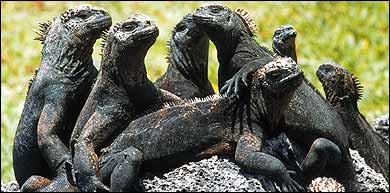In 1835, Charles Darwin's historic voyage to the Galapagos Islands 500 miles off the coast of Ecuador opened a wealth of information regarding evolution and natural selection as the mechanism for the creation of a species. Today, visitors to the 13 major volcanic islands can witness first-hand the same environment that gave Darwin his inspiration: an isolated Eden laden with endemic plant and wildlife entirely unaffected by the outside world and accustomed to the peering curiosity of human visitorsand their cameras.
Virtual Galápagos
Check out our all-new Galápagos and .To better acquaint you with one of the world's most unique locales, the Away Network exposes you to our history of Galápagos coverage in the hopes that it'll get you there, and soon.
Also, check out the April 2005 issue of ���ϳԹ��� Magazine, which features Julian Smith's article “Galápagos Rising”, detailing the latest, greatest ways to get to and around the isles!
Vital Stats: when to go, how to get there, what to see, what to pack, and what to know before you go.
Evolution happens: One visitor's discovery of evolutionary history, and the human effects on the islands and their inhabitants.
While Darwin pronounced these lizards “hideous,” the marine iguana is one of the Galápagos' many endemic species, and the only seagoing lizard in the world.
Excellent animal encounters abound on winter's five best wildlife cruises.
Welcome to the archipelago and its major tourist hotspots via the best way to explore: by boat.
From GORP.com:
From the blue-footed booby to the flightless cormorant, discover what flies (and what doesn't) in the Galápagos bird world.
Discover insight, curiosity, and imagination, and learn the history and future of the “Laboratory of Evolution.”
Drop that seashell! Read up on park rules and regulations, as well as a description of each of the major islands.

